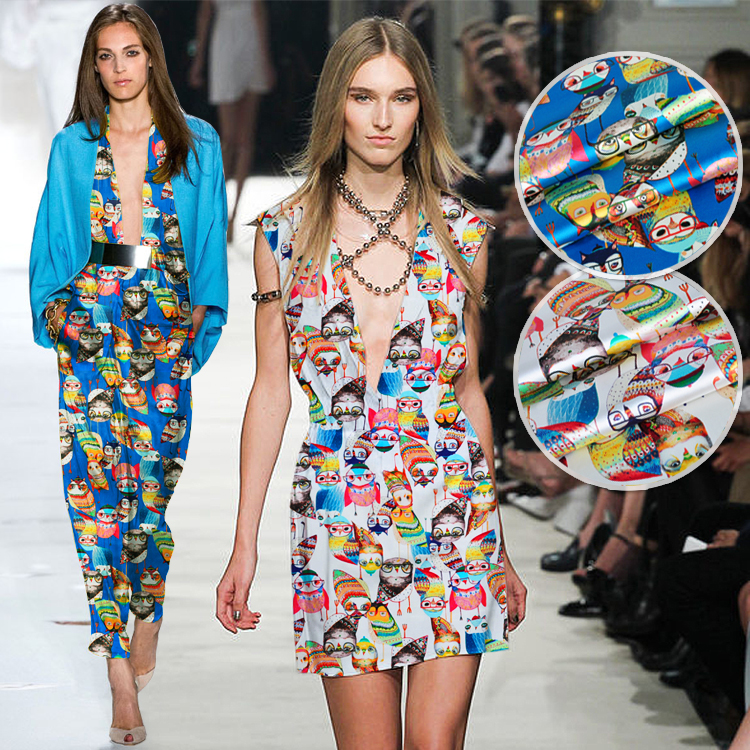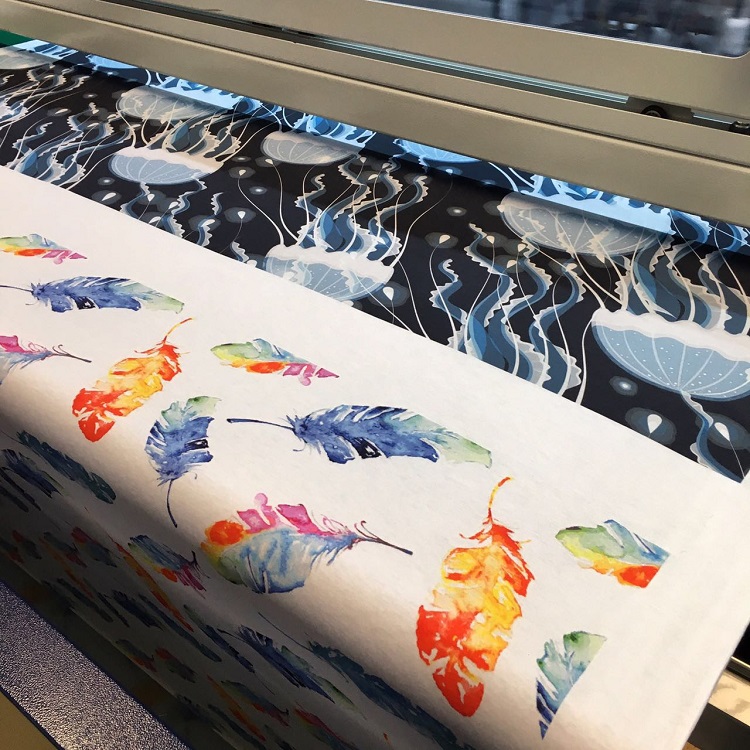Allover sublimation printing in garment decoration
 Allover sublimation printing in garment decoration is beginning to revolutionize how consumers shop. A garment style can be selected (as a white polyester blank) — along with a pattern or graphic — and a totally custom garment can be created immediately.
Allover sublimation printing in garment decoration is beginning to revolutionize how consumers shop. A garment style can be selected (as a white polyester blank) — along with a pattern or graphic — and a totally custom garment can be created immediately.Customization is a major benefit of sublimation printing. And short-run, custom, quick-turn production is not only the future; it's here now.
The process can be broken into four primary areas: signs/banners; hard substrates, such as mugs and phone cases; fashion; and sports apparel.
Dye-sublimation inks are comprised of a disperse dye suspended in liquid, commonly water. The image is printed on coated heat-resistant, tacky transfer paper as a reverse image of the final design. Through heat pressing, the graphic is transferred from the paper onto white polyester fabric.
The term "sublimation transfer" would imply a print being adhered to a garment's surface, as is the case with plastisol transfers. But these sublimation prints are permanent, as the dye bonds to the polyester on a molecular level. The resulting print will have absolutely no "hand" or feel on the fabric. Also, when repeatedly worn and laundered, sublimation-printed fabric holds its color beautifully.
 The obvious difference between large-format and desktop sublimation printing is the maximum output size you can accomplish. A lesser-known difference is the substantial discrepancy in ink costs. While the ink cost for a single coffee mug would be calculated in dollars on a desktop printer, the same coffee mug image on a large-format printer would be calculated in pennies. Remember, just because your printer is capable of 42- or 62-inch print-width capacity, the paper roll can be much smaller.
The obvious difference between large-format and desktop sublimation printing is the maximum output size you can accomplish. A lesser-known difference is the substantial discrepancy in ink costs. While the ink cost for a single coffee mug would be calculated in dollars on a desktop printer, the same coffee mug image on a large-format printer would be calculated in pennies. Remember, just because your printer is capable of 42- or 62-inch print-width capacity, the paper roll can be much smaller.What Prints and What Doesn't:
The standard fabric for sublimation printing is white polyester. In the case of hard substrates, items with a polyester coating are ideal. And yes, you may have seen colored garments with sublimation decoration. You can print light colors, but since the sublimation inks are transparent, the graphic will take on the garment color.
For instance, if you print a blue ball on a light-yellow polyester garment, the resulting ball will be a shade of green. So, if a color shift is not important, you can print light-colored, 100% polyester fabrics as well.
You also can print on blended fabric, such as 50% polyester/50% cotton, but be aware that sublimation inks only will bond with the polyester. The finished print will have a washed-out, retro appearance, but there are decorators who print and sell such items. Of course, the higher the polyester content in the blended fabric, the better the finished print will appear.
Garments made of 100% cotton, even if white, are not an option with sublimation inks, as they will not adhere to cotton fabric.
Sublimation printing on finished garments sometimes can show white voids where the fabric was folded and, therefore, not decorated. These white areas in the image, usually around seams, are referred to as "smiles" by some industry professionals. They are more acceptable in the fashion marketplace, as long as your customer understands the process and the chance that they may appear.
There are two primary options for heat pressing large-format sublimation transfers. One is a large, flatbed base with a horizontal heat press similar to a tabletop, swing-away model used for smaller products. These may have a heat element on the top, or on the top and bottom.
The second is rotary heat press calander where the garment and transfer paper are fed through rollers. The transfer and polyester fabric feed between a roller that is heated with oil or via electricity, and then pinched between a felt pad that is pressed against the heat with a secondary small drum.
The sublimation transfer is laid out, ink side up, on a preparation table. Because of the garment's non-rigid nature, a tacky paper is best suited to hold the material in place without movement, which would cause ghosting in the finished print.
More info:
Website: www.skyimagepaper.com
Company Name: Fei Yue Digital Technology Co.,LTD
E-mail: sales@feiyuepaper.com
Tel: 86-025-86628894
Whatsapp: +86 18252072197
Address: Central Road 323, Nanjing, Jiangsu, China



Sublimation is now a days most using in designing the clothes and in many kinds of sports uniforms just like Slow Pitch Softball Uniforms and it i in demand these days.
回复删除